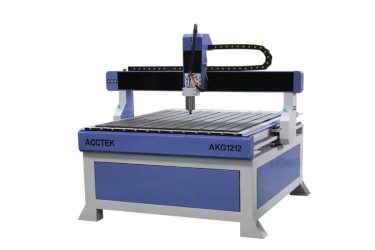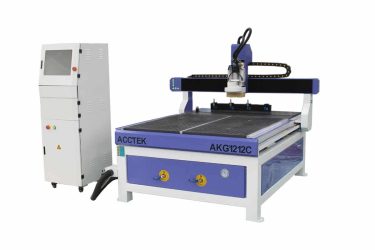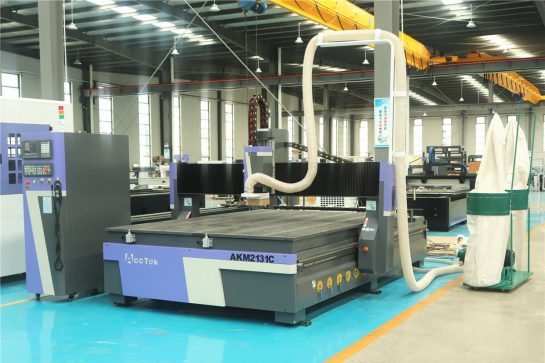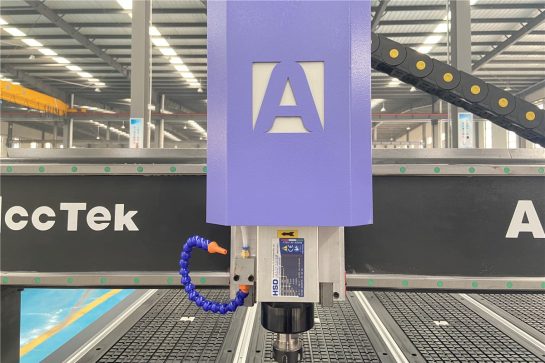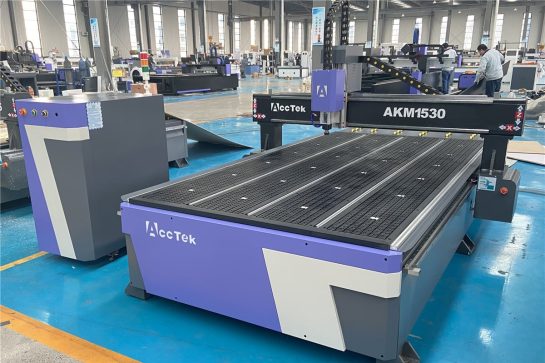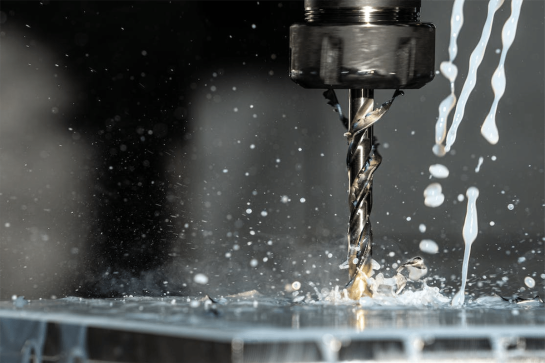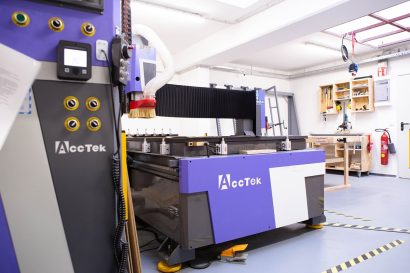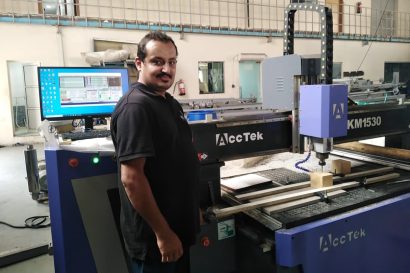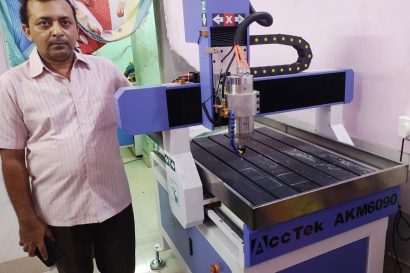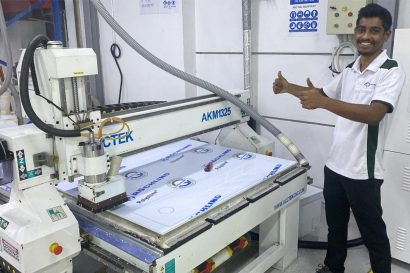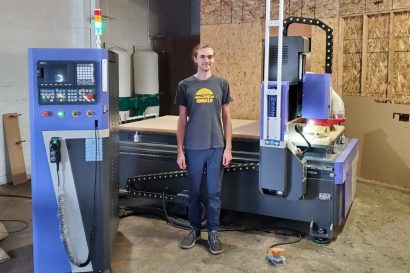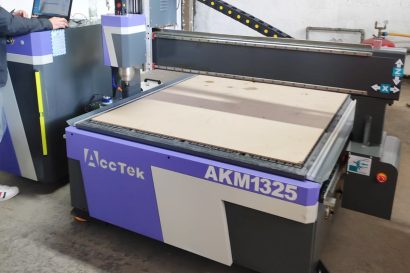1212 CNC Router
The 1212 CNC router is a lead screw CNC router designed for precision cutting and engraving tasks. The working dimensions of these CNC routers are 1200mm x 1200mm. It is compact and powerful, suitable for a variety of applications. This CNC router operates based on a screw mechanism, providing accurate and efficient motion control during processing.
The 1212 CNC router is available in various types to meet the needs of different industries. Whether woodworking, metal processing, or plastic manufacturing, the 1212 CNC router can easily adapt to different materials. The screw drive system ensures precise movement along the X, Y, and Z axes, enabling intricate designs and fine details in the finished product. With its user-friendly interface and advanced control system, the 1212 CNC router is the first choice for hobbyists, craftsmen, and professionals looking for efficient, precise machining capabilities in compact spaces.
Tips for Choosing a Suitable 1212 CNC Router
Starting the journey to choose the perfect 1212 CNC router? We’ll guide you through the basic considerations when choosing the perfect 1212 CNC router for your machining needs. From material compatibility to control systems, every tip is carefully designed to enable beginners and experienced craftsmen alike to make informed decisions. Whether you want to try CNC machining or upgrade your equipment, we will help you solve the complex problems of finding the ideal 1212 CNC router to increase your accuracy and productivity.
Application requirements
Start by clearly defining your application requirements. Consider the specific tasks you need your CNC router to perform, such as cutting, engraving, or milling, and identify any unique features or specifications that are critical to your project.
Material compatibility
Evaluate the materials you plan to use and make sure the 1212 CNC router is compatible. Different materials may require specific spindle speeds, cutting tools, and machine stiffness. Choose a CNC router suitable for the various materials you plan to use.
Machine rigidity and structure
Check the rigidity and structure of the CNC router. Rugged and well-built machines help improve operational stability and minimize vibrations that can affect accuracy. The sturdy frame and high-quality components indicate durability.
Spindle power and speed
Consider available spindle power and speed options. Higher spindle power is good for cutting tougher materials, while variable speed control lets you adapt to different tasks. Make sure the spindle specifications match your project needs.
Speed and feed rate
Evaluate the machine’s speed and feed rate capabilities. The ability to control these parameters helps optimize cutting efficiency and achieve the desired surface finish. Look for a CNC router with adjustable speed and feed settings.
Control System
Study the control system and software that comes with the CNC router. A user-friendly interface and compatibility with common CNC software facilitates seamless operation of the machine. Consider whether the control system allows for easy programming and customization.
Drive System
Check the drive system, especially the mechanisms responsible for movement along the X, Y, and Z axes. Ball screws and high-quality linear guides contribute to smoother, more precise movement. Precise and reliable drive systems help achieve accurate and repeatable results.
Accuracy and Tolerance
Review the machine’s accuracy specifications and tolerance levels. Look for features like high-quality linear guides and ball screws that help achieve tight tolerances in machined parts. Check for features like backlash compensation and feedback systems that improve accuracy.
Compatibility with software
Make sure the CNC router is compatible with the software you plan to use to design and generate toolpaths. Compatibility with industry-standard software simplifies the integration process and ensures a smoother workflow and programming experience.
Budget considerations
Define your budget constraints and compare the features offered by different 1212 CNC routers within that budget. Consider not only the initial purchase cost but also potential long-term expenses such as maintenance and upgrades. Balance cost considerations with the capabilities of your machine to find the best value for your investment.
Customization options
Explore whether the CNC router offers customization options or if additional features can be integrated later. This flexibility enables you to adapt your machine to changing requirements and ensures a longer machine life as your needs change.
User reviews and recommendations
Research user reviews and seek advice from individuals experienced with the specific 1212 CNC router model you are considering. Real-world insights can provide valuable information about performance, reliability, and any potential challenges users may encounter.
What materials can a 1212 CNC router cut?
The 1212 CNC router, with its compact size and versatile capabilities, can cut a variety of materials. The specific materials it can handle may depend on factors such as the spindle power, cutting tools, and overall machine rigidity. Generally, a 1212 CNC router can cut materials such as:
Wood
- Pine
- Oak
- Maple
- Plywood
- MDF
- Cedar
- Teak
Plastics
- Acrylic
- PVC
- HDPE
- LDPE
- Polycarbonate
- PET
- PU
Metal
- Stainless Steel
- Carbon Steel
- Aluminum
- Brass
- Copper
- Titanium
- Gold
Others
- Rubber
- Carbon Fiber
- Laminates
- Leather
- Glass
- Stone
- Ceramics
Application Industry

Construction Industry
The integration of CNC routers into construction workflows has ushered in a new era characterized by meticulous detailing, rapid prototyping, and improved material utilization.

Aerospace Industry
The CNC router is widely used in aerospace engineering due to its unparalleled ability to carve complex designs, manufacture complex parts, and ensure tight tolerances.

Jewelry Industry
The CNC router revolutionize the way fine jewelry is designed and made by delivering unparalleled precision and efficiency and producing intricate designs with meticulous attention to detail.

Stone Carving Industry
The integration of CNC routers into the stone carving industry is not only revolutionizing the way craftsmen carve, it is also redefining the boundaries of artistic possibilities in this ancient practice.
Blog
How to Reduce the Impact of Workpiece Adhesion on CNC Router Cutting Quality
This article delves into practical strategies for mitigating the impact of workpiece adhesion on CNC router cutting quality, to improve the performance and reliability of CNC router operations.
Read More
Addressing Environmental Concerns in CNC Router Waste Disposal: A Comprehensive Guide
In this article, we delve into the considerations for the correct disposal of waste materials from CNC router operations, aiming to tackle the environmental challenges posed by CNC waste.
Read More
Guide to Optimizing CNC Router Parameters for Diverse Materials
This article provides a systematic parameter optimization method for CNC routers cutting different materials, aiming to provide users with the necessary knowledge to achieve excellent processing quality.
Read More
Understanding the Perils of Spindle Runout in CNC Routers
This article delves into the causes of spindle runout and strategies for mitigating its effects, aiming to provide you with the knowledge to optimize CNC router performance.
Read More
Mastering CNC Router Worktables: A Comprehensive Guide
This article delves into the CNC router types, operating methods, maintenance, and customization options, providing you with the knowledge to optimize your CNC router settings for superior results.
Read More
CNC Router Bits: Complete Buyer’s Guide
From understanding the different types of CNC router bits to deciphering the nuances of materials and coatings, this guide provides the essential reference for finding the right bit for your ...
Read More
Frequently Asked Questions
What is a 1212 CNC router?
The 1212 CNC router refers to a computer numerical control (CNC) machining tool with a work area of 1200mm x 1200mm. This square workspace defines the machine’s ability to precision cut, engrave, and mill a variety of materials. CNC systems enable automated and high-precision operations under the guidance of computer-aided design (CAD) or computer-aided manufacturing (CAM) software. The 1212 CNC router is renowned for its versatility, meeting the needs of a range of applications including woodworking, rubber processing, plastic manufacturing, and more.
The 1212 CNC router is equipped with a screw drive mechanism to ensure precise movement along the X, Y, and Z axes. Its compact size makes it suitable for a variety of environments, from hobbyist workshops to small industrial settings. The functionality of this CNC router combined with a user-friendly interface makes it the first choice for those seeking efficient and reliable machining solutions for complex designs and diverse materials.
How much is a 1212 CNC router?
The cost of a 1212 CNC router can vary significantly based on its features, specifications, and additional functionalities. Entry-level models, offering basic cutting and carving capabilities, typically start around $4000. These machines are suitable for hobbyists and small-scale projects, providing an affordable entry point into CNC machining.
The Automatic Tool Changer (ATC) can be an attractive option for those seeking more advanced capabilities. CNC routers equipped with an ATC system allow for automatic tool changes during machining operations, enhancing efficiency. The cost for an ATC-enabled 1212 CNC router generally falls in the range of $8500.
The rotary axis attachments, which enable the machining of cylindrical objects, can add versatility to a CNC router. The cost for a rotary axis attachment for a 1212 CNC router typically ranges from $4500 to $68000, depending on factors such as build quality, precision, and additional features.
For professionals and industries requiring intricate multi-axis machining, a 5-axis 1212 CNC router is a premium option. These machines, capable of moving the cutting tool along five different axes, offer advanced precision and flexibility. The cost for a 5-axis 1212 CNC router is typically around $65000.
It’s important to note that these price ranges are general estimates, and actual costs may vary based on factors such as brand, build quality, additional features, and the supplier’s pricing strategy. Prospective buyers should carefully consider their needs and budget constraints when selecting a 1212 CNC router.
If you want to get the accurate price of a 1212 CNC router, you can contact us at any time. Our engineers and sales managers will provide you with the most suitable machine and quotation based on your specific requirements.
Which type of oil is used to lubricate the 1212 CNC router?
The type of oil used to lubricate the 1212 CNC router depends on the specific component and the manufacturer’s recommendations. In CNC routers, moving parts such as linear guides, ball screws, and other mechanical components often require lubrication to reduce friction and wear. Commonly used lubricants for CNC routers include:
- Motor Oil: Light motor oils are generally suitable for general lubrication purposes. Its low viscosity can effectively reduce the friction of various moving parts and help maintain the smooth movement of mechanical parts.
- Grease: Grease can be used on parts that require a higher viscosity lubricant, such as ball screws and bearings. It provides better adhesion and stays in place, providing long-lasting lubrication.
- White Lithium Grease: This type of grease is known for its versatility and is used in CNC routers to lubricate components such as ball screws and linear guides.
- Synthetic Lubricants: Some CNC milling machines may benefit from synthetic lubricants, which increase temperature resistance and extend lubrication intervals.
What software do you provide for the 1212 CNC router?
AccTek CNC provides 1212 CNC routers with two software options: Mach3 and Syntec 610MA-E5. Mach3 is a widely used CNC control software known for its user-friendly interface and compatibility with various CNC machines. The Syntec 610MA-E5, developed by Syntec, is a high-performance CNC control system with advanced features suitable for milling, engraving, and cutting applications.
If customers have specific software preferences other than Mach3 or Syntec 610MA-E5, AccTek CNC also offers customization services. You can select or request alternative CNC control software to meet your specific needs. The flexibility to provide customization services allows AccTek CNC to cater to a broader range of software preferences, ensuring that customers have the tools that best fit their workflow and requirements.
How to calibrate the 1212 CNC router?
Calibrating the 1212 CNC router helps ensure machining precision and accuracy. The following are general guidelines for calibrating the 1212 CNC router:
- Check Power Supply And Connections: Make sure the CNC router is properly connected to the power supply and that all cables and connections are secure.
- Inspect Mechanical Components: Inspect all mechanical components, including ball screws, linear guides, and bearings. Make sure there is no excessive wear or damage. Tighten any loose bolts or screws. Make necessary repairs or adjustments.
- Check And Adjust Unit Steps: Unit steps are the number of steps required for the motor to move a specific distance. Check and adjust the steps per unit setting in CNC control software (such as Mach3 or Syntec 610MA-E5) to match the actual motion of the machine. This calibration ensures accurate positioning.
- Verify Axis Alignment: Check that the machine moves accurately along each axis. Measure the distance traveled and compare it to the commanded distance. Adjust steps for each unit or make mechanical adjustments as needed.
- Calibrate Acceleration And Velocity: Set appropriate acceleration and velocity values in the CNC control software. These parameters determine how quickly the machine accelerates and moves. Calibrate them to achieve the desired cutting speed without sacrificing accuracy.
- Calibrate The Spindle Speed: Use a tachometer to calibrate its speed. Compare the measured speed to the programmed speed and make adjustments in the control software.
- Verify Machine Geometry: Use precision measurement tools to check machine geometry, such as squareness and parallelism. If necessary, adjust the machine to correct any deviation from the specified dimensions.
- Test Cutting: Test cuts are made on scrap material to verify the accuracy of machine movement. Measure the dimensions of the test cuts to ensure they fit the intended design.
- Fine-Tune Parameters: Fine-tune acceleration, velocity, and other parameters in CNC control software to optimize performance and achieve desired results.
- Repeat If Necessary: Calibrate and test multiple times to ensure results are consistent and accurate. Adjust as necessary to achieve the desired accuracy.
- Documentation: Record the calibration settings and any adjustments made. This document can be used as a reference for future maintenance or troubleshooting.



